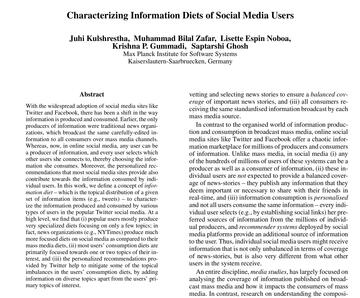
With mass media communications, each consumer receives the same standardised information broadcast by each source, and there is a limited number of sources. With social media, each consumer is also a producer of information, and the composition of the information to which one is exposed is personalised.
The authors of this paper, published on the Proceedings of the 9th International Conference on Web and Social Media, sponsored by the Association for the Advancement of Artificial Intelligence, define “information diet” as the composition of all the information consumed or produced by the user, focusing on the topical composition of users’ diet. They created a publicly-available application measuring the information diets produced and consumed by Twitter users and conducted a comparative analysis of the topical compositions of the information diets produced, consumed, and recommended on social media and mass media.
The authors extracted "keywords" (hashtags and URLs) from tweets. They used those keywords to infer the topics of the tweets. To do that, they relied on the assumption that if many users interested in a certain topic are discussing a particular keyword, that keyword is most likely related to that topic. For this study, they used 18 topical categories: arts-crafts, automotive, business-finance, career, education-books, entertainment, environment, fashion-style, food-drink, health-fitness, hobbies, paranormal, politics-law, religion, science, society, sports, and technology.
The three news organisations that the authors examined (The New York Times, The Washington Post, and The Economist) had multiple accounts on Twitter: one primary account and several topic-specific accounts. The study considered the primary account, which invariably has a bigger number of followers than the others.
The authors' first question was if there are there differences between the information diets published by news organisations over mass media and social media. They found that primary accounts of news organisations in social media tend to publish less content on those topics for which there exist topic-specific accounts, as compared to the corresponding mass media diets. Even the primary social media accounts of news organisations tend to be more specialised in their production by focusing on fewer topics, as compared to their mass media diets.
The authors than selected a random sample of popular/influential accounts, to study their information diet. They identified a top topic for each user. They found that popular users, on average, post a significant fraction of their diet (between 20% and 50%) on just their top topic.
They looked at the distribution of the 500 randomly selected verified users across their top topics: most users have their top topic as one of three topics, namely entertainment, sports, and politics, but there are small fractions of popular users focusing their diets on all the other topics as well.
They then compared the information diet of the Twitter random sample with the mass media diets of The New York Times and The Washington Post: the Twitter social media diet is more heavily biased towards entertainment (39%), while the mass media diets focus more on politics (30%). Topics such as technology, hobbies-tourism, paranormal, and career are over-represented in the social media diet as compared to mass media diet. On the contrary, topics such as food, health, and society are covered more in mass media than in social media.
The authors then selected a random sample of Twitter users, and studied the tweets that they received from their followers. They found out that users in social media consume a much larger fraction of their information diet on their primary topic or topics of interest, as compared to what they would consume from a typical mass media source. This comes at the cost of the other topics.
Twitter and other social media deploy recommendation systems to enable users discover content that would be interesting to them. Recommendations do not always match their consumed diet, so they tend to even out the imbalances in the consumed diets of the users.
Tags: Social media Data journalism United KingdomThe content of this article can be used according to the terms of Creative Commons: Attribution-NonCommercial 4.0 International (CC BY-NC 4.0) . To do so use the the wording "this article was originally published on the Resource Centre on Media Freedom in Europe" including a direct active link to the original article page.

